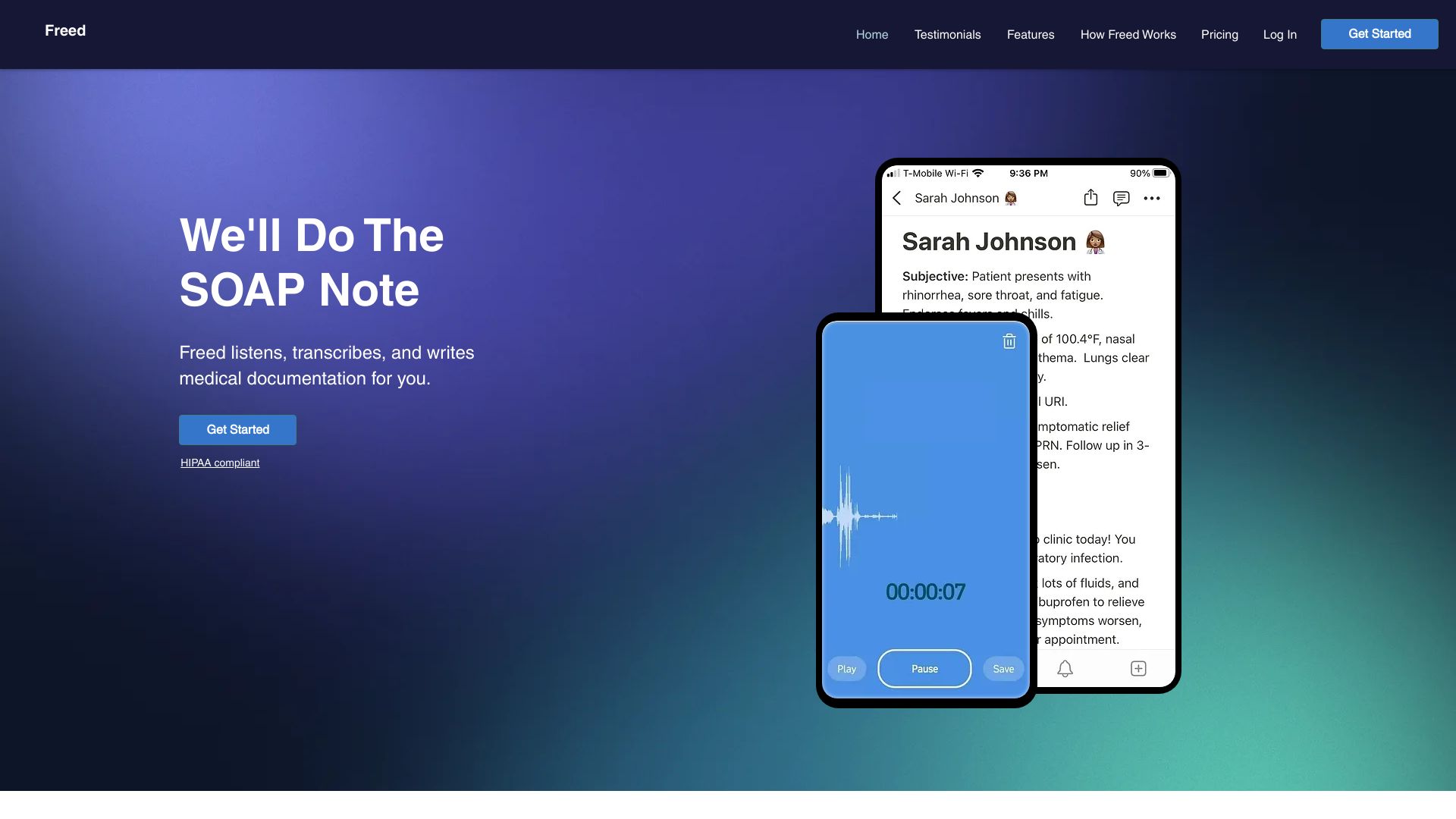- Home
- AI Speech-to-Text
- Freed

Freed
Open Website-
Tool Introduction:AI medical scribe for faster notes: records, summarizes, EHR sync.
-
Inclusion Date:Oct 21, 2025
-
Social Media & Email:
Tool Information
What is Freed AI
Freed AI is an AI medical scribe that listens to patient encounters, transcribes clinician–patient conversations, and converts them into structured clinical documentation. By automating note creation, it helps clinicians reclaim time, reduce after-hours charting, and keep records consistent. Freed integrates with EHR systems to streamline chart updates and supports multiple specialties, from primary care to subspecialties. Teams use it to generate accurate visit summaries and SOAP-style notes while staying focused on patient care.
Freed AI Main Features
- Ambient listening and capture: Securely records clinical encounters to minimize manual note-taking during visits.
- Medical-grade transcription: Converts speech to text with speaker differentiation to preserve clinical context.
- AI summarization: Produces structured outputs such as HPI, exam findings, assessment, and plan, aligned with SOAP-style documentation.
- Customizable templates: Specialty- and workflow-specific note templates to match clinic preferences and compliance needs.
- EHR integration: Streamlined export or handoff of finalized notes into EHR charts to reduce duplicate work.
- Review and edit workflow: Clinicians can verify, edit, and approve drafts before sign-off.
- Team administration: Role-based access, shared templates, and consistent documentation standards across providers.
- Security considerations: Designed to support healthcare privacy best practices; verify compliance requirements for your organization.
Who Should Use Freed AI
Freed AI is suitable for physicians, PAs, NPs, and clinical teams in outpatient clinics, hospital-based practices, and telehealth settings who want to reduce documentation time and improve note consistency. It fits primary care and a range of specialties where accurate, structured visit summaries and EHR-ready documentation are essential.
How to Use Freed AI
- Create an account and set up your clinic profile, roles, and permissions.
- Connect available EHR integrations or define your preferred export workflow.
- Select or customize templates for your specialty and note format (e.g., SOAP).
- With patient consent, start ambient recording during the visit to capture the conversation.
- Review the AI-generated draft, make edits, add codes or orders as needed, and approve.
- Export or sync the finalized note to the patient’s chart in the EHR.
- Iterate templates and prompts over time to match evolving clinical workflows.
Freed AI Industry Use Cases
In a primary care clinic, Freed AI can capture wellness visits and chronic disease follow-ups, producing concise SOAP notes that reduce end-of-day charting. Specialty practices—such as cardiology or orthopedics—can use it to standardize consult notes and post-op follow-ups. Telehealth providers can run ambient capture during virtual visits and push approved summaries to the EHR to keep remote workflows efficient.
Freed AI Pricing
Freed AI is generally offered as subscription software with plan tiers that vary by user count, features, and integrations. Trials or demos may be available to evaluate clinical fit. For current plan details, availability, and any volume options, refer to the vendor’s official materials.
Freed AI Pros and Cons
Pros:
- Reduces documentation time and after-hours charting.
- Generates structured, consistent clinical notes aligned with common formats.
- EHR integration streamlines chart updates and reduces duplicate data entry.
- Customizable templates adapt to different specialties and workflows.
- Supports team-wide standards with review and approval controls.
Cons:
- Requires clear audio and patient consent to ensure quality capture.
- Drafts still need clinician review for accuracy and clinical judgment.
- EHR integration and change management may require initial setup time.
- Subscription costs and data governance considerations must be evaluated.
Freed AI FAQs
-
Does Freed AI replace clinical documentation entirely?
No. It drafts notes from the encounter, but clinicians review, edit, and sign off to ensure clinical accuracy and completeness.
-
How does EHR integration work?
After approval, notes can be exported or synced into the patient chart through supported integrations or defined workflows, reducing manual copy-paste.
-
Is it suitable for telehealth visits?
Yes. With consent and clear audio, it can capture virtual encounters and generate EHR-ready summaries for remote care.
-
What documentation formats can it produce?
It supports structured outputs such as SOAP-style notes and can be tailored with templates for different specialties.
-
What about privacy and security?
The tool is designed with healthcare privacy in mind. Confirm policies, data handling, and compliance requirements with your organization and the vendor.



